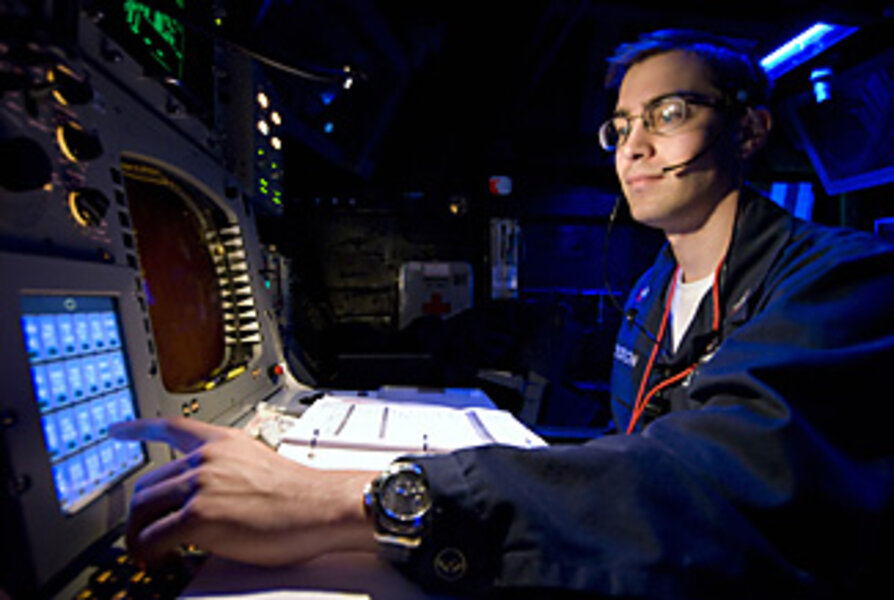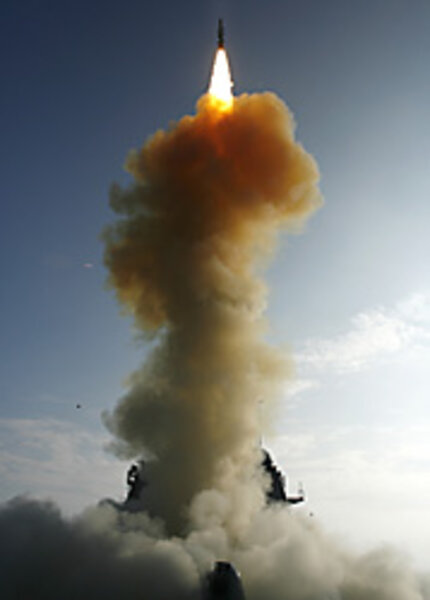U.S. missile shoots down satellite - but why?
Loading...
| Washington
Yes, the Pentagon can obliterate a broken satellite tumbling at the edge of space. The question is, why bother?
That is the reaction of some experts to the successful destruction Feb. 20 of a dead US spy satellite 153 miles over the Pacific Ocean.
The official explanation – that the US wanted to prevent the toxic contents of the spacecraft's fuel tank from hitting the ground – seems a bit thin, according to James Lewis, director of the technology and public policy program at the Center for Strategic and International Studies. Thus critics from around the world have speculated about ulterior motives, ranging from a desire to test US ballistic missile defenses to poking China in the eye.
Mr. Lewis says he thinks the Defense Department crunched the numbers and found there was a chance the satellite might come down somewhere embarrassing, or dangerous, like the landmass of a foreign country. He thinks it was not the fuel tank's toxic hydrazine fuel, but a more general desire to prevent any impact, that led to the decision to shoot it down.
"It was a surfeit of caution," says Lewis.
A three-stage Navy SM-3 missile hit the satellite 153 miles up, just northwest of Hawaii, said military officials at a Feb. 21 news conference.
The missile's kill vehicle contained no explosives and had to maneuver into the path of the satellite and collide with it, destroying it with kinetic force. The spacecraft – described as being about the size of a school bus, and weighing about 5,000 pounds – exploded spectacularly.
That fireball likely indicates that the frozen hydrazine fuel was destroyed, said military officials, but they won't know for sure until Feb. 23 or 24.
"Our objective was to intercept the satellite, reduce the mass that might survive reentry, [and] vector that mass into unpopulated areas, ideally the ocean," said Gen. James Cartwright, vice chairman of the Joint Chiefs of Staff.
The military has long described the difficulty of hitting an object in space with a missile as being akin to striking a bullet with another bullet. With the 25th anniversary of President Ronald Reagan's original speech calling for a Strategic Defense Initiative coming up on March 23, the US has now fully demonstrated such a capability.
"Yes, this was uncharted territory," said General Cartwright. "The technical degree of difficulty was significant here. You can imagine that at the point of intercept there were a few cheers that went up."
Last year, China used a newly developed antisatellite missile to destroy a weather satellite orbiting 528 miles above the earth. The unannounced move surprised the world and caused the US to react with anger and concern.
The US spy satellite destruction was different from the Chinese move for two reasons, according to US officials. It was announced in advance. The Chinese move was not. It also took place at a low orbit, meaning the resultant cloud of debris for the most part will fall into the atmosphere and burn up. The Chinese antisatellite missile left a cloud of debris in a higher orbit, endangering other spacecraft.
But both the Chinese and the Russians complained about the US move, saying it risked accelerating an arms race in space and showed the hypocrisy of America's criticism of China.
"China is continuously following closely the possible harm caused by the US action to outer-space security and relevant countries," said Chinese Foreign Ministry spokesman Liu Jianchao at a news conference in Beijing.
Some critics say there's now a danger that the US move will provide other nations an excuse to move forward with their own programs.
Given that it has the most satellites of any nation, and its military depends more heavily on space assets than does any other, the US should be taking the lead in pressing for an international ban on weapons in space, said Laura Grego, an astrophysicist with the Union of Concerned Scientists, in an analysis of the impact of the satellite's destruction.
"The potential cost of shooting down this satellite is high.... Demonstrating an antisatellite weapon is counterproductive to US long-term interests."






